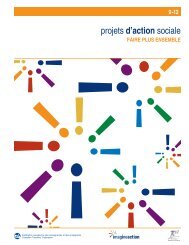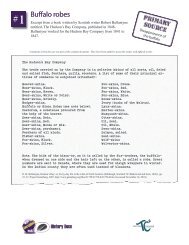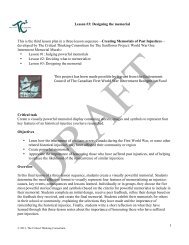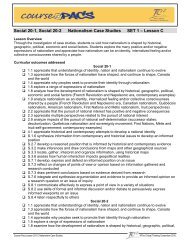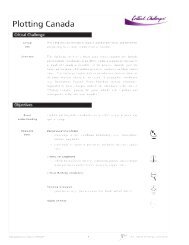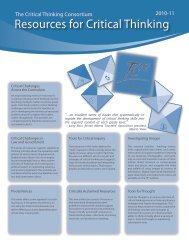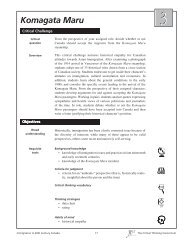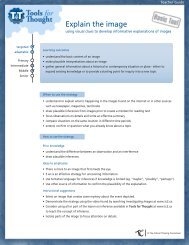Inquiry-mindedness - The Critical Thinking Consortium
Inquiry-mindedness - The Critical Thinking Consortium
Inquiry-mindedness - The Critical Thinking Consortium
Create successful ePaper yourself
Turn your PDF publications into a flip-book with our unique Google optimized e-Paper software.
RESEARCHSTRATEGYTEACHER RESOURCE #5Credibility of sourcesassessing whether or not sources of information are reliableObjectives: • Learn to identify the most credible sources of information for a research topicor question;• Understand the importance of assessing the credibility of research sources.Use the following activities to systematically introduce the featured research strategy.Introducethe strategy➤➤Invite students to imagine that they have been given the taskof investigating the theft of a world famous painting worthmillions of dollars from a museum. While the thieves wereable to disarm the alarm systems, security cameras recordedthe theft. Unfortunately, the security footage did not clearlycapture the faces of the culprits. Inform students thattheir task is to interview three potential witnesses to thecrime and determine whose account of the heist is themost reliable. Provide students with a copy of Witnessprofiles (Activity Sheet #5A) and give them time toread the profiles.Witness profilesACTIVITY SHEET #5A➤➤➤➤➤➤Ask students to identify which of the three witnessesthey believe provides the most reliable or accurateaccount of the theft. Encourage students to explainwhy some accounts of the theft may be more or less reliable thanothers (for example, a witness may have a poor reputation or offer an accountthat is verified by other sources).Tools for Thought 2008-09:3 43 © <strong>The</strong> <strong>Critical</strong> <strong>Thinking</strong> <strong>Consortium</strong>Invite students to consider when it would be important to consider the credibility of a source (examplesof sources: oral accounts, written sources, websites). Invite students to suggest criteria fordetermining whether or not a source is credible. Use student responses to develop the followingcriteria for assessing credibility:• expertise: Was the source created by a qualified individual or group? For example, a sourceon cooking created by a trained professional chef may be more credible than one created bysomeone with no culinary training.• reputation: Was the source created by an individual or group with a reputation for qualitywork? For example, an article written by a scientist who has written more than 30 articles maybe more credible than an information from a website known for questionable research.• corroborated: Does the source include information from other sources that matches the detailsin the source? For example, a story in a tabloid newspaper that does not have any sourcesthat support the story would be less credible than an account that is supported by several eyewitnesses’accounts.Using the three criteria for credibility as categories, prompt students to think of questions thatcould be asked to discover more about the source. For example:• expertise: What are the qualifications of the author? Has the publisher developed other similarresources?• reputation: How do other writers or researchers think of this author? Is the work of the publisherconsidered reliable and accurate?Tools for Thought 2008–09:3 40 © <strong>The</strong> <strong>Critical</strong> <strong>Thinking</strong> <strong>Consortium</strong>



